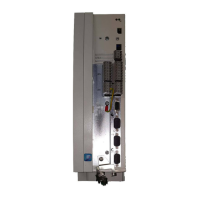Braking operation
Rated data of the integrated brake transistor
12
12.3
12.3−2
EDSVF9383V EN 7.1−04/2012
Rated data for types EVF93xx−EVV270 and EVF93xx−EVV300 at 400 V or 460 V rated mains voltage
Brake transistor
9300 vector
EVF9335−EVV270
EVF9335−EVV300
EVF9336−EVV270
EVF9336−EVV300
EVF9337−EVV270
EVF9337−EVV300
EVF9338−EVV270
EVF9338−EVV300
Threshold V
DC
[V DC] 755
Peak brake current [A DC] 315 375 450 560
Max. continuous
current
[A DC] 210 250 300 375
Lowest permissible
brake resistance
1)
[W] 2.5 2.1 1.8 1.4
Current derating Derate the peak brake current by 2.5 %/°C above 40 °C
Derate the peak brake current by 5 %/1000 m above 1000 m a.m.s.l.
Switch−on cycle
3)
max. 60 s braking at peak brake power, followed by min. 30 s break
Brake transistor
9300 vector
EVF9381−EVV270
2)
EVF9381−EVV300
2)
EVF9382−EVV270
2)
EVF9382−EVV300
2)
EVF9383−EVV270
2)
EVF9383−EVV300
2)
Threshold V
DC
[V DC] 755
Peak brake current [A DC] 2 × 375 2 × 450 2 × 560
Max. continuous
current
[A DC] 2 × 250 2 × 300 2 × 375
Lowest permissible
brake resistance
1)
[W] 2.1 1.8 1.4
Current derating Derate the peak brake current by 2.5 %/°C above 40 °C
Derate the peak brake current by 5 %/1000 m above 1000 m a.m.s.l.
Switch−on cycle
3)
max. 60 s braking at peak brake power, followed by min. 30 s break
1)
Please consider the cable resistance if you use longer connection cables. The cable resistance must
be added to the brake resistance and has therefore a considerable influence on the total
resistance.
2)
Device consists of master and slave connected in parallel. Usually, the brake energy is dissipated
evenly via master and slave.
3)
Please see the switch−on cycle of the brake resistor used.

